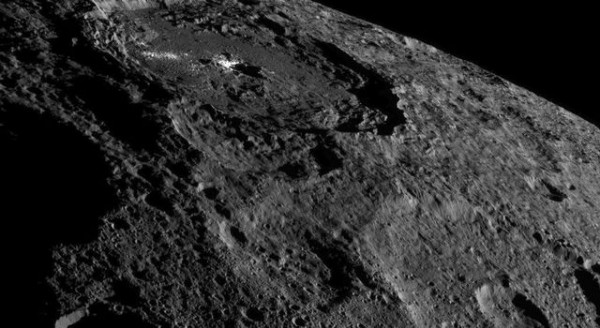By Ana Verayo, | November 22, 2016

Occator Crater, home of Ceres' intriguing brightest areas, is prominently featured in this image from NASA's Dawn spacecraft. (NASA/JPL-Caltech/UCLA/MPS/DLR/IDA)
NASA's Dawn spacecraft revealed its newest batch of images of the mysterious dwarf planet, Ceres, which has exceptionally bright, white spots on its surface. This new imagery, captured on October 16, is especially mesmerizing as it features these mysterious spots in dramatic lighting.
Like Us on Facebook
These sparkling, white spots are located inside the dwarf planet's Occator Crater, measuring 57 miles across and 2.5 miles deep. Inside this crater lies two of the brightest white spots. Dawn observations suggest that they consist of salty material exposed from an asteroid impact.
Scientists suggest that these bright spots have been geologically active for millions of years. The asteroid impact could have caused a salty liquid to burst from the interior of Ceres, and this brine emerged on the surface. When this occurred, the brine rapidly became frozen before ice turned into vapor, leaving behind these sparking, salt deposits.
This new image was taken during Dawn's extended mission and its fifth orbit around Ceres from an altitude of 920 miles. The spacecraft captured the most unprecedented details yet of the dwarf planet.
Dawn's extended mission involves more detailed experiments and measurements using gamma ray and neutron spectrometry to peer through Ceres at three feet deep, including gravitational measurements that can provide more clues about its interior.
Apart from this, the spacecraft is also conducting observations using visible and infrared light to identify the mineralogical composition of Ceres. Since Dawn is now in higher orbit, the spacecraft will remap the dwarf planet and collect imagery from the same regions at different times of the day and conduct topographical mapping.
NASA's Dawn spacecraft completed its primary mission in July. It is also the first spacecraft to visit two planetary objects in the Main Asteroid Belt between Mars and Jupiter, Vesta and Ceres. Dawn is slated to permanently stay in Ceres' orbit until it runs out of fuel.
-
Use of Coronavirus Pandemic Drones Raises Privacy Concerns: Drones Spread Fear, Local Officials Say

-
Coronavirus Hampers The Delivery Of Lockheed Martin F-35 Stealth Fighters For 2020

-
Instagram Speeds Up Plans to Add Account Memorialization Feature Due to COVID-19 Deaths

-
NASA: Perseverance Plans to Bring 'Mars Rock' to Earth in 2031

-
600 Dead And 3,000 In The Hospital as Iranians Believed Drinking High-Concentrations of Alcohol Can Cure The Coronavirus

-
600 Dead And 3,000 In The Hospital as Iranians Believed Drinking High-Concentrations of Alcohol Can Cure The Coronavirus

-
COVID-19: Doctors, Nurses Use Virtual Reality to Learn New Skills in Treating Coronavirus Patients







